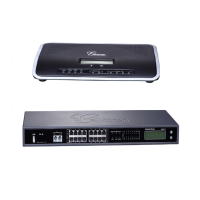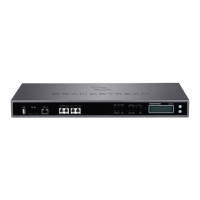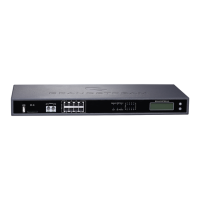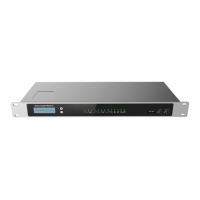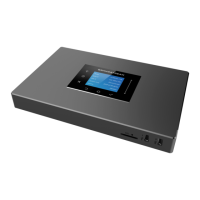UCM6XXX Analog Trunks Guide
Table 1: Analog Trunk Configuration Parameters
Select the channel where analog trunk is connected (Channel 1, Channel2…)
• UCM6202/UCM6102/UCM6510: 2 channels
• UCM6204/UCM6104: 4 channels
• UCM6208/UCM6108: 8 channels
Note: Users can select multiple channels if the trunk is using multiple lines. Please
refer to [DAHDI Out Line Selection] for more options.
Specify a unique label to identify the trunk when listed in outbound/inbound rules.
Enable this option to satisfy two primary use cases, which include emulating a simple
key system and creating shared extensions on a PBX. Enable SLA Mode will disable
polarity reversal. Please refer to Enabling SLA Mode section for more details.
Available only if “SLA Mode” is enabled, the barge option specifies whether or not
other SLA stations are allowed to join a call in progress on this trunk. If enabled, the
other stations can press the line button to join the call. The default setting is Yes.
Available only if “SLA Mode” is enabled, the hold option specifies hold permissions
for this trunk. If set to “Open”, any SLA station can place this trunk on hold and any
other SLA station is allowed to retrieve the call. If set to “Private”, only the station that
places the call on hold can retrieve the call. The default setting is Yes.
If enabled, a polarity reversal will be marked as received when an outgoing call is
answered by the remote party. For some countries, a polarity reversal is used for
signaling the disconnection of a phone line and the call will be considered as “hang
up” on a polarity reversal. The default setting is “No”.
When FXO port answers the call, FXS may send a Polarity Reversal. If this interval is
shorter than the value of “Polarity on Answer Delay”, the Polarity Reversal will be
ignored. Otherwise, the FXO will on-hook to disconnect the call. The default setting is
600ms.
Current Disconnect
Threshold (ms)
This is the periodic time (in ms) that the UCM6200 will use to check on a voltage drop
in the line. The default setting is 200. The valid range is 50 to 3000.
Configure the ring timeout (in ms). Trunk (FXO) devices must have a timeout to
determine if there was a Hangup before the line is answered. This value can be used
to configure how long it takes before the UCM6200 considers a non-ringing line with
Hangup activity. The default setting is 8000.
Configure the RX gain for the receiving channel of analog FXO port. The valid range
is from -13.5 (dB) to + 12.0 (dB). The default setting is 0.
Configure the TX gain for the transmitting channel of analog FXO port. The valid
range is from -13.5 (dB) to + 12.0 (dB). The default setting is 0.

